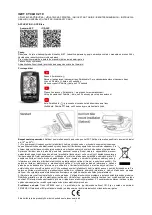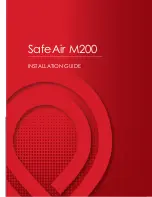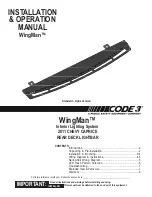
Page 2
Strap Mounting:
1.
Locate the mounting foot, anchor plate and locking plate included
with your lightbar. If not already present, install the locking plate onto
the mounting foot. When properly positioned, this plate is centered
from side-to-side on the mounting foot.
2.
Flip the lightbar upside-down to expose the bottom of the extrusion
and place the mounting foot onto the extrusion.
3.
Rotate the mounting foot 90° in a counter-clockwise direction. Make
sure that the edges of the mounting foot swing into position under the
extrusion mounting lip. Install an anchor plate onto the extrusion in
the same manner.
4.
Repeat this procedure for the remaining mounting foot and anchor
plate and return the lightbar to its right side-up position.
5.
Position the lightbar onto the vehicle roof in the desired mounting
location. One often selected location is directly above the B-pillars.
This area is the strongest part of the roof. Refer to your lightbar
manual for cable exit location, to be sure that the lightbar is facing the
proper direction.
6.
Adjust the two mounting feet outwards so that they are as close to
the edge of the roof as possible. Both mounting feet must be in full
contact with the roof. Be sure that there is no less than 1/2” clearance
between roof and lightbar at
their closest point. When the
mounting feet are in their
proper position, lightly tighten
the locking plate allen head set
screws.
7.
Return the lightbar to an
upside-down position. Slide
each anchor plate outwards
until it is fully engaged with its
corresponding mounting foot.
With the mounting feet and
anchor plates in their proper
positions firmly tighten all of the set screws (2 or 4 per side). Flip the
lightbar right side-up and return it to its mounting position.
8.
Open both drivers side doors. In the area directly below the mounting
foot, pull the weatherstrip away from the vehicle so the area where
the mounting strap will be secured is exposed. Repeat for the other
side.
9.
Insert the mounting strap through the mounting foot. Be sure that the
strap fits flush against the area where it will be secured onto the
vehicle. Insert the tension bolt through the mounting strap and
anchor plate, into the tinnerman nut. Tighten slightly with a long-
shafted, Phillips screwdriver. Repeat procedure for passenger side.
10. If your mounting strap has mounting holes in the end of the strap, use
these holes as a template to drill appropriately sized pilot holes
through the strap and into the vehicle. Repeat for passenger side of
the vehicle.
11. Firmly tighten the tension bolts to secure the lightbar to the vehicle.
NOTE: Model MKAJ is an adjustable mounting foot. On this model
you may loosen the screws on the rear of the foot and adjust the
angle of the lightbar. This feature can be used if the angle of the roof
is not level with the road. IMPORTANT: To adjust the leveling screws
you must use a torque wrench set at 35 to 40in./lbs.
IMPORTANT! The lightbar should be located a minimum of
16" from any radio antennas!
Permanent Mounting:
1.
Locate the mounting foot and locking plate included with your
lightbar. If not already present, install the locking plate onto the
mounting foot. When properly positioned, this plate is centered from
side to side on the mounting foot.
2.
Flip the lightbar upside-down to expose the bottom of the extrusion
and place the mounting foot onto the extrusion.
3.
Rotate the mounting foot 90° in a counter-clockwise direction. Make
sure that the edges of the mounting foot swing into position under the
extrusion mounting lip.
4.
Repeat this procedure for the remaining mounting foot and return the
lightbar to its right side-up position.
5.
Position the lightbar onto the vehicle roof in the desired mounting
location. One often selected location is directly above the B-pillars.
This area is the strongest part of the roof. Refer to your lightbar
manual for cable exit location, to be sure that the lightbar is facing the
proper direction.
6.
Adjust the two mounting feet outwards so that they are as close to
the edge of the roof as possible. Make sure that both mounting feet
are in full contact with the roof. Be sure that there is no less than 1/2”
clearance between the roof and the lightbar at their closest point.
When the mounting feet are in their proper position, lightly tighten the
locking plate allen head set screws.
7.
Turn the lightbar upside down and firmly tighten all of the set screws
from step 6 (2 or 4 per side).
8.
On the adjustable foot, use the hole in the pad as a guide to drill the
two holes into the mounting foot at the locations shown.
9.
Place the lightbar in its final mounting position on the vehicle, mark
the mounting hole locations off onto the mounting surface, remove
the lightbar and drill the mounting holes.
10. Place the lightbar back onto the vehicle lined up with the mounting
holes and secure the mounting feet to the vehicle with the supplied
hardware.
Insert foot into extrusion with locking plate
attached.
Twist mounting foot into
position
ANCHOR
PLATE
Loosely secure foot and locking plate.
Mounting
Pad
Adjustable
Mounting
Foot
Washer
Nut
Mounting
Foot
Base
Standard
Mounting
Foot
Mounting
Pad
Washer
Nut
Locking
Plate
Bolt
Bolt
























